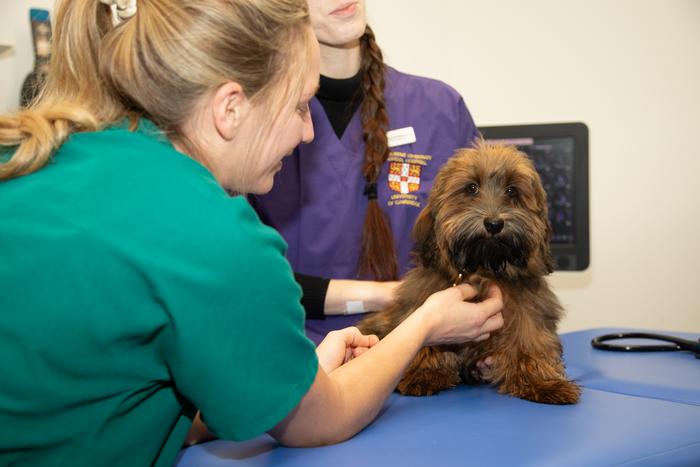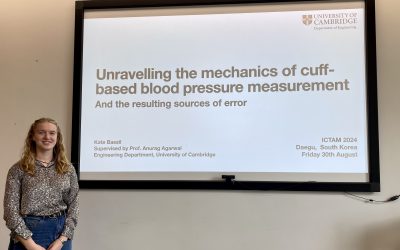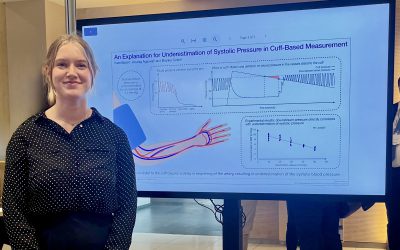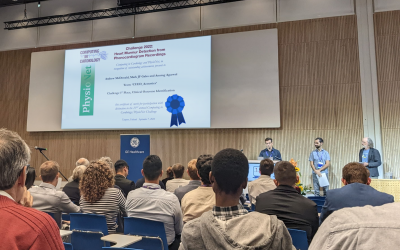Publications
A M, MJF G, A A: A recurrent neural network and parallel hidden Markov model algorithm to segment and detect heart murmurs in phonocardiograms. In: PLOS DIGITAL HEALTH, vol. 3, iss. 11, no. e0000436, pp. 1–20, 2024. @article{MGA24,
title = {A recurrent neural network and parallel hidden Markov model algorithm to segment and detect heart murmurs in phonocardiograms},
author = { McDonald A and Gales MJF and Agarwal A},
doi = {10.1371/journal.pdig.0000436},
year = {2024},
date = {2024-11-25},
urldate = {2024-11-25},
journal = {PLOS DIGITAL HEALTH},
volume = {3},
number = {e0000436},
issue = {11},
pages = {1--20},
keywords = {},
pubstate = {published},
tppubtype = {article}
}
|
McDonald A, Matos J N, Silva J, Partington C, Lo E J Y, Fuentes V L, Barron L, Watson P, Agarwal A: A machine-learning algorithm to grade heart murmurs and stage preclinical myxomatous mitral valve disease in dogs. In: Journal of Veterinary Internal Medicine, 2024. @article{canine_jvim,
title = {A machine-learning algorithm to grade heart murmurs and stage preclinical myxomatous mitral valve disease in dogs},
author = {Andrew McDonald and Jose Novo Matos and Joel Silva and Catheryn Partington and Eve J. Y. Lo and Virginia Luis Fuentes and Lara Barron and Penny Watson and Anurag Agarwal},
doi = {https://doi.org/10.1111/jvim.17224},
year = {2024},
date = {2024-10-21},
urldate = {2024-10-21},
journal = {Journal of Veterinary Internal Medicine},
abstract = {Background: The presence and intensity of heart murmurs are sensitive indicators of several cardiac diseases in dogs, particularly myxomatous mitral valve disease (MMVD), but accurate interpretation requires substantial clinical expertise.
Objectives: Assess if a machine-learning algorithm can be trained to accurately detect and grade heart murmurs in dogs and detect cardiac disease in electronic stethoscope recordings.
Animals: Dogs (n = 756) with and without cardiac disease attending referral centers in the United Kingdom.
Methods: All dogs received full physical and echocardiographic examinations by a cardiologist to grade any murmurs and identify cardiac disease. A recurrent neural network algorithm, originally trained for heart murmur detection in humans, was fine-tuned on a subset of the dog data to predict the cardiologist's murmur grade from the audio recordings.
Results: The algorithm detected murmurs of any grade with a sensitivity of 87.9% (95% confidence interval [CI], 83.8%-92.1%) and a specificity of 81.7% (95% CI, 72.8%-89.0%). The predicted grade exactly matched the cardiologist's grade in 57.0% of recordings (95% CI, 52.8%-61.0%). The algorithm's prediction of loud or thrilling murmurs effectively differentiated between stage B1 and B2 preclinical MMVD (area under the curve [AUC], 0.861; 95% CI, 0.791-0.922), with a sensitivity of 81.4% (95% CI, 68.3%-93.3%) and a specificity of 73.9% (95% CI, 61.5%-84.9%).
Conclusion and Clinical Importance: A machine-learning algorithm trained on humans can be successfully adapted to grade heart murmurs in dogs caused by common cardiac diseases, and assist in differentiating preclinical MMVD. The model is a promising tool to enable accurate, low-cost screening in primary care.
},
keywords = {},
pubstate = {published},
tppubtype = {article}
}
Background: The presence and intensity of heart murmurs are sensitive indicators of several cardiac diseases in dogs, particularly myxomatous mitral valve disease (MMVD), but accurate interpretation requires substantial clinical expertise.
Objectives: Assess if a machine-learning algorithm can be trained to accurately detect and grade heart murmurs in dogs and detect cardiac disease in electronic stethoscope recordings.
Animals: Dogs (n = 756) with and without cardiac disease attending referral centers in the United Kingdom.
Methods: All dogs received full physical and echocardiographic examinations by a cardiologist to grade any murmurs and identify cardiac disease. A recurrent neural network algorithm, originally trained for heart murmur detection in humans, was fine-tuned on a subset of the dog data to predict the cardiologist's murmur grade from the audio recordings.
Results: The algorithm detected murmurs of any grade with a sensitivity of 87.9% (95% confidence interval [CI], 83.8%-92.1%) and a specificity of 81.7% (95% CI, 72.8%-89.0%). The predicted grade exactly matched the cardiologist's grade in 57.0% of recordings (95% CI, 52.8%-61.0%). The algorithm's prediction of loud or thrilling murmurs effectively differentiated between stage B1 and B2 preclinical MMVD (area under the curve [AUC], 0.861; 95% CI, 0.791-0.922), with a sensitivity of 81.4% (95% CI, 68.3%-93.3%) and a specificity of 73.9% (95% CI, 61.5%-84.9%).
Conclusion and Clinical Importance: A machine-learning algorithm trained on humans can be successfully adapted to grade heart murmurs in dogs caused by common cardiac diseases, and assist in differentiating preclinical MMVD. The model is a promising tool to enable accurate, low-cost screening in primary care.
|
Bassil KJ, Agarwal A, Celler B: Unravelling the mechanics of cuff-based blood pressure measurement and the resulting sources of error. In: Proceedings of the 26th International Congress of Theoretical and Applied Mechanics, pp. 581-2, IUTAM 2024. @inproceedings{Bassil2024,
title = {Unravelling the mechanics of cuff-based blood pressure measurement and the resulting sources of error},
author = {KJ. Bassil and A. Agarwal and BG Celler},
year = {2024},
date = {2024-08-30},
urldate = {2024-08-30},
booktitle = {Proceedings of the 26th International Congress of Theoretical and Applied Mechanics},
pages = {581-2},
organization = {IUTAM},
abstract = {Auscultatory blood pressure measurement is the gold standard against which other non-invasive measurement devices are calibrated. However, this method systematically underestimates systolic and overestimates diastolic blood pressure. The overestimation is explained by known causes of error - primarily the stiffness of the artery and surrounding tissue. Within this context, the underestimation of systolic pressure seems paradoxical. We show that the systolic measurement is affected by changes to the arterial pressure, occurring when the blood pressure cuff is applied. The occlusion of the artery results in low pressure downstream of the cuff. Through varying parameters in a novel experimental rig, we demonstrate that the lower this downstream pressure, the greater the underestimation of the systolic pressure. Our results suggest a need for a new, more accurate measurement protocol.},
keywords = {},
pubstate = {published},
tppubtype = {inproceedings}
}
Auscultatory blood pressure measurement is the gold standard against which other non-invasive measurement devices are calibrated. However, this method systematically underestimates systolic and overestimates diastolic blood pressure. The overestimation is explained by known causes of error - primarily the stiffness of the artery and surrounding tissue. Within this context, the underestimation of systolic pressure seems paradoxical. We show that the systolic measurement is affected by changes to the arterial pressure, occurring when the blood pressure cuff is applied. The occlusion of the artery results in low pressure downstream of the cuff. Through varying parameters in a novel experimental rig, we demonstrate that the lower this downstream pressure, the greater the underestimation of the systolic pressure. Our results suggest a need for a new, more accurate measurement protocol. |
McDonald A, Agarwal A, Williams B, Liu N, Ladlow J: Neural network analysis of pharyngeal sounds can detect obstructive upper respiratory disease in brachycephalic dogs. In: PLOS ONE, vol. 18, iss. 8, no. e0305633, pp. 1–16, 2024. @article{MAW24,
title = {Neural network analysis of pharyngeal sounds can detect obstructive upper respiratory disease in brachycephalic dogs},
author = {A. McDonald and A. Agarwal and B. Williams and N-C Liu and J. Ladlow},
doi = {10.1371/journal.pone.0305633},
year = {2024},
date = {2024-08-22},
journal = {PLOS ONE},
volume = {18},
number = {e0305633},
issue = {8},
pages = {1--16},
keywords = {},
pubstate = {published},
tppubtype = {article}
}
|
Bugeat B, Karban U, Agarwal A, Lesshafft L, Jordan P: Acoustic resolvent analysis of turbulent jets. In: Theoretical and Computational Fluid Dynamics, vol. 38, pp. 687–706, 2024. @article{bugeat2024acoustic,
title = {Acoustic resolvent analysis of turbulent jets},
author = {Benjamin Bugeat and Ugur Karban and Anurag Agarwal and Lutz Lesshafft and Peter Jordan},
year = {2024},
date = {2024-05-20},
urldate = {2024-01-01},
journal = {Theoretical and Computational Fluid Dynamics},
volume = {38},
pages = {687--706},
publisher = {Springer},
keywords = {},
pubstate = {published},
tppubtype = {article}
}
|











